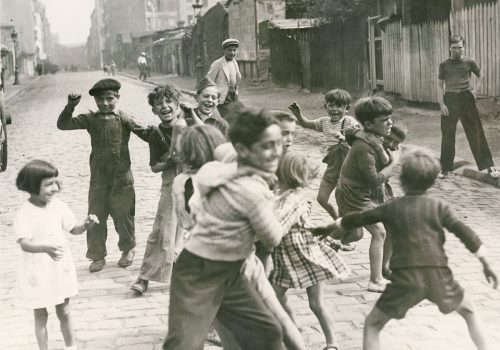In contact with the enclosure, all around it, a singular swarm had developed, and almost fixed itself. A membrane of population, just half a kilometer thick, but stretched out over thirty-six; a sort of annular city stuck to the other and alive with its residues. The military zone, which forbade houses, tolerated hovels and barracks. A people of irregulars, nomads, fallen, or immigrants waiting, had taken the opportunity to settle there, clinging to the clay, muddy, clandestine, still half-floating, which was gradually sinking into the soil of habits, traditions, rights. A whole new Bohemian nation, soft in appearance like glue on the carapace of the rampart, but tenacious in reality like a disease, and which, when the rampart had cracked, would still resist.
Jules Romains, Men of Good Will, 1932-1946
At the end of the 19th century, “the Zone” is a strip of land that surrounds Paris. 250 meters wide, it is located in front of the “fortifications”, which commonly referred to the ramparts of the enclosure of Thiers, erected in 1844. Affected by a servitude not aedificandi (non-constructible), it was progressively occupied by a very poor population called “the zoners”. In 1926, there were more than 42,000 people living in this vast slum, an abundance of precarious constructions, unsanitary barracks lacking electricity and access to water. From the beginning, the Parisian bourgeoisie worried about this “belt of misery unworthy of the capital” that it associates with the myth of the Parisian slums. In 1919, the government began the dismantling of the fortifications and undertook a vast construction site of cheap housing (HBM) with the project of a green belt covered with parks and sports fields on the site of the zone. But the expropriations are lagging behind and faced with the difficulty of managing this urban margin, the development of the area is constantly postponed. During the Second World War, the Vichy regime carried out an accelerated expulsion and the complete eradication of the area. The last zoners are repulsed to further suburbs or to the provinces and disappear from the view of Parisians. In 1956, the construction of the ring highway finally buried beneath the bitumen traces of a marginal territory, of a poor population, a type of precarious housing, a mode of existence unsuited to the new urban order.
Composed of about 150 period photographs covering the period 1910-1960, the exhibition traces the history of the Zone. Collected one by one for years, these images are rare. Unlike literature and cinema, which largely contributed to shaping an image of the Zone with colorful characters such as the Apaches or the ragpickers, the photography of the inter-war period was little interested in this social phenomenon .
The majority of the photographs exhibited are the work of anonymous photographers, some of whom responded to assignments designed to demonstrate “the sordid aspect that is hard to imagine if we have not had the opportunity to travel the Zone”. As a result, the interest of the exhibition lies mainly in its documentary character, which removes it from the picturesque image of the Zone that could be seen in post-war humanist photography. Closer to the photographic report of Eugène Atget, gathered in his album “Les zoniers”, the exhibition does not subscribe to authority from one point of view, but by the diversity of the ensembles that compose it, underlines the strength of the documentary photograph that finds and testifies to a “it has existed”.
Today, as a resurgence of theZone, we see reappearing islands of poverty – slums, wild camps – along the ring road, symbolic barrier that encircles the city and rejects the disadvantaged, mostly foreign. Two contemporary artists, Stéphane Goudet and Lucile Boiron, question these new forms of misery that emerge for one at the gates of the city, for the other at the gates of Europe.
La Zone / The Zone
September 26 – December 8, 2018
Lumière des Roses Gallery
12-14 Rue Jean Jacques Rousseau
93100 Montreuil, France
















